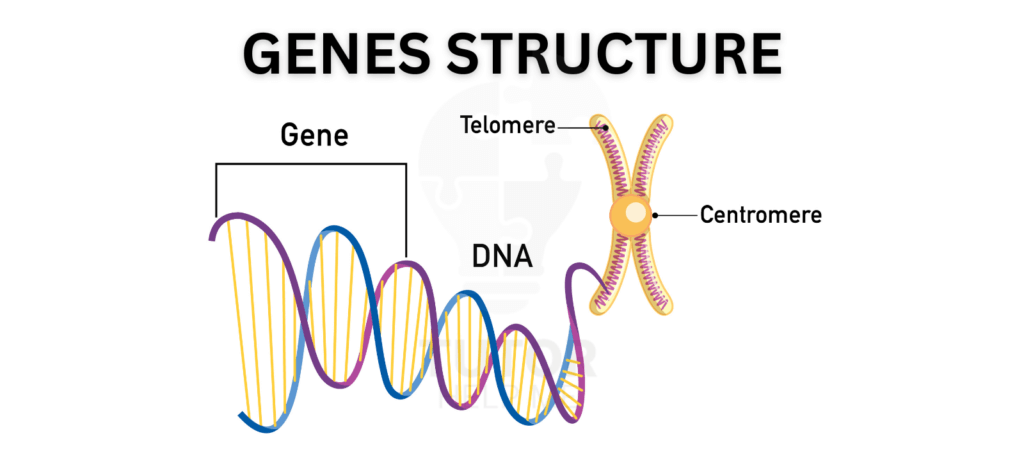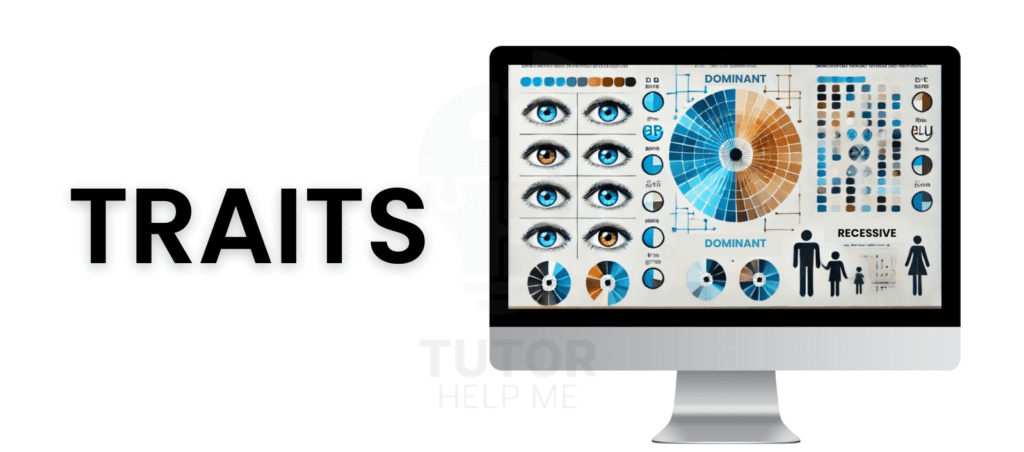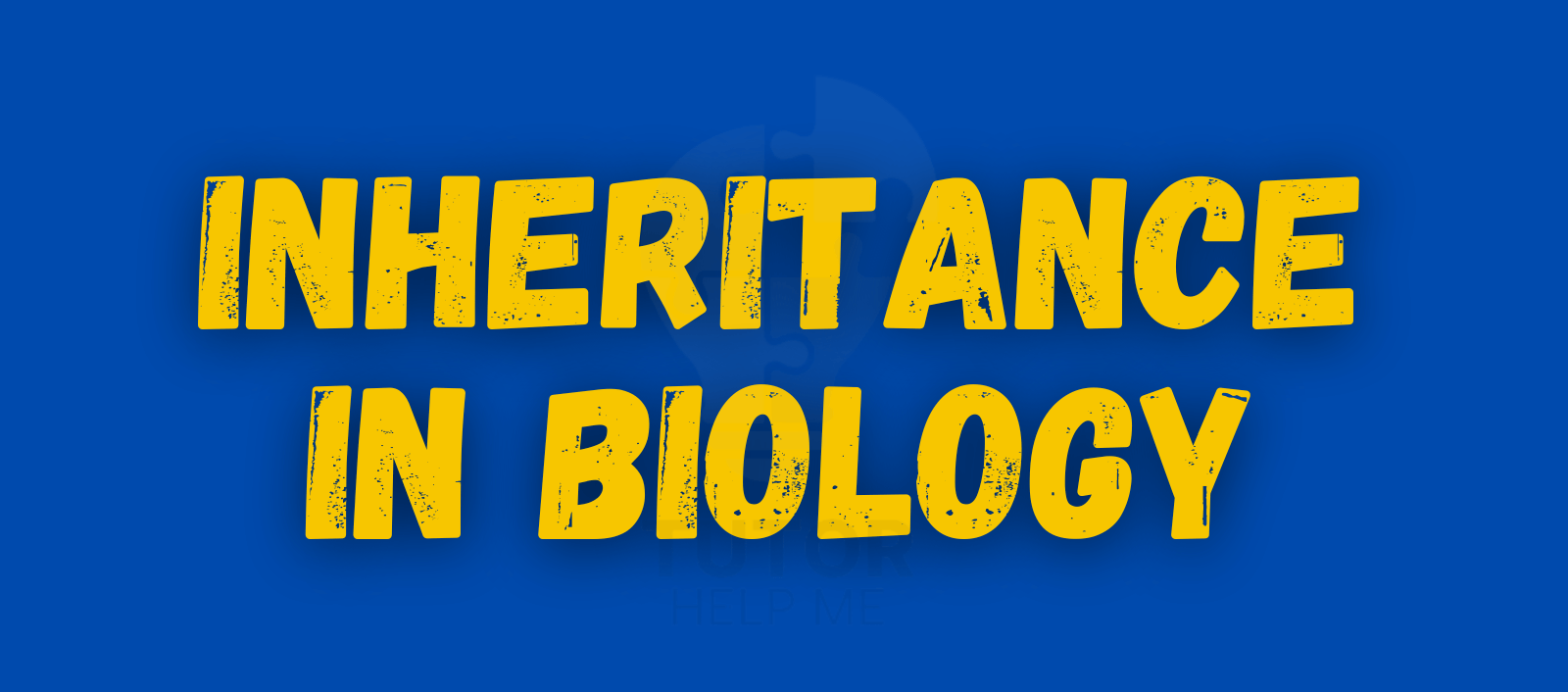Inheritance is the process by which genetic information is passed from one generation to another. It determines the characteristics of a living organism and explains why offspring often look similar to their parents. This process, called inheritance, follows specific patterns, first discovered through Mendel’s laws.
At the core of inheritance are genes, which contain instructions for traits such as eye colour, height, and even susceptibility to genetic conditions. These genes are found on chromosomes, large structures made of deoxyribonucleic acid (DNA), a large and complex polymer that carries genetic material.
How Do Traits Pass from Parents to Offspring?
Traits are inherited through genes located on the X chromosome and other chromosomes. Each organism inherits one copy of a gene from each parent. These copies, known as alleles, may be the same or different. If the two alleles are the same, the organism is homozygous for that trait; if they are different, the organism is heterozygous.
Genes exist in different forms, known as dominant or recessive alleles. A dominant allele is always expressed, even if an individual has only one copy. In contrast, a recessive allele is only expressed if the individual has two copies of the gene. This explains why some traits, like brown eyes, are more common than others, such as blue eyes.
For example, the allele for brown eyes is said to be dominant, while the allele for blue eyes is masked or suppressed unless an individual inherits two copies of the recessive gene.
Why is Inheritance Important in Living Organisms?
Inheritance is crucial because it ensures that genetic characteristics are passed from parent to offspring, maintaining the continuity of life. It also allows for genetic variation, which plays a significant role in evolution and adaptation.
Passing on Traits
Through sexual reproduction, offspring inherit traits from both parents, leading to a combination of genetic makeup. This is why no two individuals, except identical twins, have the same genotype and phenotype.
Role of Chromosomes in Inheritance
Organisms inherit sex chromosomes from their parents. Humans have either an X or a Y chromosome, which determines biological sex. A child inherited from the mother always gets an X chromosome, while the chromosome inherited from the father can be either X or Y, determining if the child is male (XY) or female (XX).
Inheritance and Genetic Conditions
Some inherited genetic conditions result from mutations, or changes in genes. These can be caused by changes in DNA sequences, leading to conditions such as cystic fibrosis or sickle cell disease. Understanding human genetics helps scientists develop treatments for recessive genetic disorders.
Understanding Genes, DNA, and Traits
Inheritance is the way genetic information is passed from one generation to another. This process explains why offspring share similar characteristics with their parents. Traits like eye colour, hair type, and height are all determined by genes. Understanding how DNA, genes, and traits work together helps explain genetic inheritance and variation among individuals.
What Are Genes, and How Do They Control Traits?
Genes are sections of deoxyribonucleic acid (DNA) that determine the characteristics of a living organism. Each gene contains instructions for making proteins, which influence how the body develops and functions.
Genes exist in different forms called alleles. Some alleles are dominant, meaning they are always expressed, while others are recessive and only appear if an individual has two copies of the recessive allele.
For example, the allele for brown eyes is dominant, while the allele for blue eyes is recessive. If a person inherits one copy of the dominant allele and one copy of the recessive allele, they will have brown eyes because the dominant allele is always expressed. However, if they inherit two copies of the allele for blue eyes, they will have blue eyes.

How Does DNA Store Genetic Information?
DNA is a large and complex polymer made up of nucleotides. It contains the genetic material that determines the genetic makeup of an organism. DNA is found in the chromosomes within the nucleus of a cell.
Each human cell contains 23 pairs of chromosomes, with one pair carrying the sex chromosomes (X or Y chromosome). These chromosomes are found in every cell and hold the information needed to create proteins that control traits.
The sequence of DNA bases determines which proteins are produced. This means that DNA determines the characteristics of an organism, particularly protein production, which affects traits like hair texture and skin colour.
What Is the Relationship Between Genes and Traits?
Genes provide the instructions for building proteins, which shape the phenotype—the observable characteristics of an individual. The combination of alleles inherited from the parents forms the genotype, which determines whether a trait is dominant or recessive.
- If both alleles are different, the individual is known as heterozygous.
- If both alleles are the same, the individual is known as homozygous.
Some traits are controlled by a single gene, while others are controlled by multiple genes. For example, eye colour is influenced by genes located on the X chromosome, while height is determined by several genes working together.
Some traits are inherited in Mendelian patterns, where one allele is dominant and the other is recessive. Other traits, like skin colour, involve multiple genes, making the inheritance pattern more complex.
Why Do Siblings Inherit Different Traits?
Siblings inherit genetic information from their parents, but they do not receive the same combination of alleles. This is because of sexual reproduction, which leads to genetic variation.
During reproduction, each parent passes on one copy of each gene. Since there are many possible combinations of alleles, siblings can inherit different forms of a gene. This explains why one sibling may have blue eyes, while another may have brown eyes, even though they share the same parents.
Another reason for differences among siblings is mutation. Changes in genes can occur naturally and may create variations in traits. Some mutations have no effect, while others may lead to genetic conditions.
In some cases, traits are inherited from the mother or inherited from the father, depending on whether the gene is located on the X chromosome or another chromosome.
Chromosomes and the Role of DNA in Inheritance
What Are Chromosomes, and How Do They Carry Genetic Material?
Chromosomes are structures made of DNA that store genetic information in cells. They contain genes, which control an organism’s characteristics. Each gene carries instructions for protein production, which determines traits like eye colour and height.
In humans, chromosomes are found inside the nucleus of every cell. Each cell contains 23 pairs, making a total of 46 chromosomes. These chromosomes are passed from one generation to another, ensuring that traits are inherited from our parents.
How Do Organisms Inherit Chromosomes from Their Parents?
During sexual reproduction, offspring inherit one copy of each chromosome from their mother and one from their father. This means they receive two copies of each gene, which may be the same or different.
The sex chromosomes (X or Y) determine biological sex. An individual with two X chromosomes (XX) is typically female, while one with an X and a Y chromosome (XY) is typically male. Some genetic conditions are linked to genes located on the X chromosome, such as colour blindness and haemophilia.
Genes may exist in different forms, known as alleles. The combination of alleles inherited from parents determines the genotype, which influences an individual’s phenotype (observable traits).
The Role of Dominant and Recessive Alleles in Traits
Each person inherits two alleles for a gene, one from each parent. These alleles may be dominant or recessive:
- A dominant allele is always expressed, even if only one copy is present.
- A recessive allele is only expressed if the individual has two copies (one from each parent).
For example:
- The allele for brown eyes is dominant. A person only needs one copy to have brown eyes.
- The allele for blue eyes is recessive. A person needs two copies to have blue eyes.
If an individual has two identical alleles, they are homozygous for that trait. If they have two different alleles, they are heterozygous.
Types of Inheritance and Their Effect on Traits
How Do Dominant and Recessive Traits Work?
Some traits follow Mendelian inheritance, first discovered by Gregor Mendel in his pea plant experiments. He observed that traits like flower colour followed predictable patterns:
- A dominant allele is said to be dominant because it masks or suppresses the effect of a recessive allele.
- A recessive genetic trait only appears when an individual has two copies of the recessive allele.
For example:
- In pea plants, purple flowers are dominant, while white flowers are recessive.
- In humans, having dimples is dominant, while not having dimples is recessive.
These inheritance patterns are called Mendel’s Laws and help explain how traits are passed from parent to offspring.
What Are Codominance and Incomplete Dominance?
Not all traits follow simple dominant or recessive rules. Some genes show codominance or incomplete dominance:
- Codominance: Both alleles are fully expressed in the phenotype.
- Example: Blood type AB results from one A allele and one B allele, showing both traits equally.
- Incomplete dominance: The phenotype is a blend of both alleles.
- Example: A red flower and a white flower producing pink offspring.
These patterns show that inheritance is more complex than just dominant or recessive genes.
What Is Sex-Linked Inheritance, and How Does It Affect Traits?
Some genes are carried on the sex chromosomes (X and Y), leading to sex-linked inheritance. Because males have only one X chromosome, they are more likely to inherit X-linked disorders.
Examples of Sex-Linked Inheritance:
- Haemophilia: A disorder where blood does not clot properly.
- Colour blindness: A condition where individuals cannot distinguish certain colours.
Since females have two X chromosomes, they may carry a recessive genetic condition without showing symptoms, while males inherit genetic conditions more easily if they receive a faulty gene.
How Do Punnett Squares Predict Inherited Traits?
A Punnett square is a simple diagram used to predict inheritance patterns. It shows the possible genetic combinations offspring may inherit based on the alleles from each parent.
Example – Brown Eyes (B) vs. Blue Eyes (b):
| Parent 1 | Parent 2 | Child 1 | Child 2 | Child 3 | Child 4 |
|---|---|---|---|---|---|
| B (Brown) | B (Brown) | BB (Brown) | BB (Brown) | BB (Brown) | BB (Brown) |
| B (Brown) | b (Blue) | Bb (Brown) | Bb (Brown) | Bb (Brown) | Bb (Brown) |
| b (Blue) | b (Blue) | bb (Blue) | bb (Blue) | bb (Blue) | bb (Blue) |
- If both parents have two dominant alleles (BB), the child will always have brown eyes.
- If one parent carries a recessive allele (Bb), there is a 50% chance of brown or blue eyes.
- If both parents have two recessive alleles (bb), the child must have blue eyes.
Punnett squares are useful in predicting genetic conditions, eye colour, and other inherited traits.

Genetic Variation, Mutations, and Trait Differences
Why Do Individuals Have Different Traits?
Each individual has unique traits, from eye colour to height. These differences result from genetic inheritance and environmental influences. Genes located on the X chromosome, along with other chromosomes found in cells, carry genetic information that determines physical and biological characteristics.
Genetic variation ensures that no two individuals, except identical twins, have the same genetic makeup. This variation allows populations to adapt and survive in changing environments.
What Causes Genetic Variation in Traits?
Genetic variation occurs due to:
- Inheritance Patterns: Traits are passed from parent to offspring through dominant or recessive alleles. Alleles are different versions of the same gene, influencing characteristics like eye colour.
- Sexual Reproduction: Each parent contributes one copy of a gene, creating diverse combinations in offspring.
- Mutations: Changes in DNA create new traits, some of which may benefit survival.
- Chromosome Shuffling: During reproduction, chromosomes are found in new arrangements, leading to different forms of traits.
How Do Mutations Create New Traits?
Mutations are changes in genes that occur naturally or due to environmental factors. They can be beneficial, harmful, or neutral.
- Beneficial Mutations: These improve survival, such as mutations that increase disease resistance.
- Harmful Mutations: These may cause genetic conditions, like types of cancer.
- Neutral Mutations: These have no noticeable effect on traits.
An example of a mutation is the allele for blue eyes, which emerged due to a genetic change in early human populations.
What Are Examples of Inherited Genetic Disorders?
Some traits are influenced by recessive genetic conditions, meaning an individual must inherit two copies of a faulty gene for the disorder to appear. Inherited genetic disorders include:
- Cystic Fibrosis – Affects the lungs and digestive system.
- Sickle Cell Anaemia – Alters red blood cell shape, causing health problems.
- Haemophilia – A recessive disorder that prevents blood from clotting properly.
These disorders follow Mendelian inheritance patterns, first studied by Gregor Mendel in pea plants. His work established the foundation of Mendelian genetics and the laws of inheritance.
The Role of Traits in Evolution and Natural Selection
How Do Inherited Traits Influence Survival and Reproduction?
Traits are inherited from our parents, but only beneficial traits increase survival chances. If an organism’s genetic characteristics improve its ability to find food, escape predators, or reproduce, it is more likely to pass on its genes to the next generation.
For example:
- Animals with camouflage traits blend into their surroundings, avoiding predators.
- Plants with stronger root systems survive droughts better than others.
This process, known as natural selection, drives the evolution of species.
Why Do Some Traits Become More Common in a Population?
Over generations, traits are passed from one generation to another if they provide an advantage. This leads to:
✔ Survival of the fittest – Organisms with favourable traits reproduce more.
✔ Elimination of harmful traits – Traits that reduce survival gradually disappear.
✔ Adaptation to the environment – Populations evolve new characteristics over time.
For example, the allele for brown eyes is more common than the allele for blue eyes due to historical advantages in sun protection.
How Does Natural Selection Shape Genetic Inheritance?
Natural selection favours traits that increase survival and reproduction. These traits become widespread due to:
- Selective Breeding: Humans influence trait inheritance, as seen in pea plants studied by Mendel.
- Genetic Drift: Random changes in allele frequencies affect small populations.
- Mutations: Changes in genes introduce new variations.
This process ensures species continue adapting to their surroundings.
Selective Breeding, Genetic Engineering, and Traits
How Does Selective Breeding Influence Inherited Traits?
Selective breeding is a process where humans choose specific organisms with desirable traits to reproduce. This method has been used for centuries to enhance genetic characteristics in plants and animals.
Process of Selective Breeding
- Identifying Traits – Farmers or scientists select organisms with similar characteristics they want to enhance.
- Breeding the Best – Only individuals with desired genetic traits are allowed to reproduce.
- Passing on Traits – The offspring inherit genetic information that makes them similar to their parents.
Examples of Selective Breeding
- Agriculture: Crops like wheat and corn are selectively bred for higher yield and disease resistance.
- Livestock: Cows are bred to produce more milk or grow larger for meat production.
- Pets: Dog breeds like Labradors are selectively bred for obedience and temperament.
Selective breeding works by influencing genetic inheritance, ensuring that dominant or recessive traits become more common over time. However, this process can reduce genetic variation, making organisms more vulnerable to genetic conditions.
Inheritance in Humans vs. Other Organisms
How Are Human Traits Inherited?
In humans, traits are passed from parent to offspring through genes located on the X chromosome and other chromosomes. Every individual inherits one copy of a gene from each parent, creating their genetic makeup.
Dominant and Recessive Traits in Humans
- Dominant Traits – Only need one copy of a dominant allele to be expressed (e.g. brown eyes).
- Recessive Traits – Require two copies of a recessive allele to appear (e.g. blue eyes).
For example, the allele for brown eyes is dominant, while the allele for blue eyes is recessive. If a person inherits one dominant allele, they will have brown eyes, but they may still pass the recessive allele to their children.
How Does Inheritance Work in Plants and Animals?
While the laws of inheritance apply to all living organisms, there are differences in inheritance patterns between humans, plants, and animals.
Inheritance in Plants
- Plants inherit genetic traits through sexual reproduction and Mendelian inheritance.
- Gregor Mendel’s experiments with pea plants demonstrated how alleles are inherited in predictable patterns.
- Traits like flower colour, seed shape, and height follow the same dominant and recessive rules as humans.
Inheritance in Animals
- Animals pass genetic characteristics to offspring through sexual reproduction.
- Some traits, like coat colour in dogs, follow Mendelian genetics.
- Inherited genetic disorders, such as recessive genetic diseases, affect both animals and humans.
Despite these similarities, animals and plants may inherit traits differently due to chromosome structures and modes of reproduction.
What is the Role of Mitochondrial DNA in Inheritance?
Mitochondrial DNA (mtDNA) is different from nuclear DNA because it is inherited only from the mother.
Key Facts About Mitochondrial DNA Inheritance
- Unlike nuclear DNA, mitochondrial DNA does not mix with the father’s genetic material.
- It is passed from one generation to another without significant changes.
- Genetic conditions related to mitochondrial mutations can be inherited directly from the mother.
Why is Mitochondrial DNA Important?
- Scientists use mtDNA to trace human ancestry and evolutionary history.
- It helps in diagnosing genetic diseases linked to cellular energy production.
Understanding mitochondrial DNA provides insight into human genetics and the way information is passed across generations.
Conclusion
Inheritance explains how genetic information is passed from one generation to another, shaping the characteristics of a living organism. Traits are controlled by genes located on the chromosomes, with variations influenced by dominant or recessive alleles.
Understanding inheritance patterns helps in studying genetic conditions, selective breeding, and evolution. Mutations can introduce changes in genes, leading to genetic diversity. Advances in human genetics and biotechnology continue to improve knowledge of Mendelian inheritance and complex traits.
Inheritance remains a fundamental concept in biology, influencing everything from eye colour to disease susceptibility, making genetics essential for scientific progress.
Read more Plant Anatomy: Roots, Stems, and Leaves

